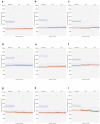Quantification of rare somatic single nucleotide variants by droplet digital PCR using SuperSelective primers
- PMID: 37923774
- PMCID: PMC10624686
- DOI: 10.1038/s41598-023-39874-0
Quantification of rare somatic single nucleotide variants by droplet digital PCR using SuperSelective primers
Abstract
Somatic single-nucleotide variants (SNVs) occur every time a cell divides, appearing even in healthy tissues at low frequencies. These mutations may accumulate as neutral variants during aging, or eventually, promote the development of neoplasia. Here, we present the SP-ddPCR, a droplet digital PCR (ddPCR) based approach that utilizes customized SuperSelective primers aiming at quantifying the proportion of rare SNVs. For that purpose, we selected five potentially pathogenic variants identified by whole-exome sequencing (WES) occurring at low variant allele frequency (VAF) in at-risk colon healthy mucosa of patients diagnosed with colorectal cancer or advanced adenoma. Additionally, two APC SNVs detected in two cancer lesions were added to the study for WES-VAF validation. SuperSelective primers were designed to quantify SNVs at low VAFs both in silico and in clinical samples. In addition to the two APC SNVs in colonic lesions, SP-ddPCR confirmed the presence of three out of five selected SNVs in the normal colonic mucosa with allelic frequencies ≤ 5%. Moreover, SP-ddPCR showed the presence of two potentially pathogenic variants in the distal normal mucosa of patients with colorectal carcinoma. In summary, SP-ddPCR offers a rapid and feasible methodology to validate next-generation sequencing data and accurately quantify rare SNVs, thus providing a potential tool for diagnosis and stratification of at-risk patients based on their mutational profiling.
© 2023. The Author(s).
Conflict of interest statement
The authors declare no competing interests.
Figures



References
Publication types
MeSH terms
Substances
LinkOut - more resources
Full Text Sources
Medical

